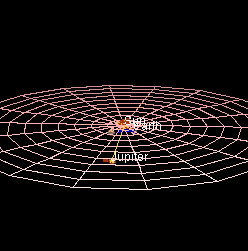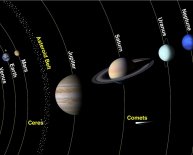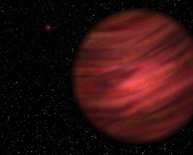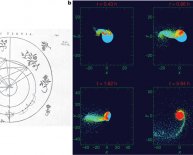
Center Of solar system
 Image credit - Wiki
Image credit - Wiki
Everything in the universe attracts everything else in the universe through the force of gravity, and the closer things are, the bigger the pull of gravity becomes.
Things that are closer together pull harder on their neighbours, and since all the planets and the sun are in relative proximity to one another, they all pull harder on each other than on stars, which are much further away.
By pulling on each other so hard, they wind up spinning, since if they weren't moving so fast, they would all just crash into each other. The rotation is all in the same direction in our solar system, much like the animation shows above. Things going faster in their orbits are closer to the sun, and things going slower are further away, just like a giant whirlpool in your bathtub. All of this started when the solar system was formed, and with nothing to stop everything from moving it will keep happening forever.
Everything in our solar system tends to orbit the centre of all the mass of the solar system. Since the sun and Jupiter are the two biggest things around, they have the most influence on everything else around the neighbourhood. The sun holds nearly all of the mass in our solar system, with everything else made up of only about 0.14% of the total. As a consequence, the centre of mass of the solar system is very nearly the middle of the sun and everything else in our solar system revolves around the sun. Or a point very near to the sun.
Edit: The sun orbits that spot, too, slowly, in tune with Jupiter's orbit of the sun (the sun doesn't really 'orbit' that spot like we do, it 'braces' itself there in a tug-o-war with the rest of us, but mainly with Jupiter).
The centre of our solar system is it's barycenter, or it's centre of mass. Please enjoy this 4 minute silent movie, the sound of space itself.
SkyMarvels™ SOLAR SYSTEM BARYCENTER (celestia celestia4all)
This behavior of nature allows us to discover strange new worlds, by observing other stars that wobble, as our sun wobbles, as long as those stars aren't too far away from us that we can't tell if they wobble or not.
Edit: this graphic is for use in a discussion in the comments section. Please ignore it here in the answer, as it doesn't really relate to the main question. I might have placed this graphic in the comments section, but I can't.

















